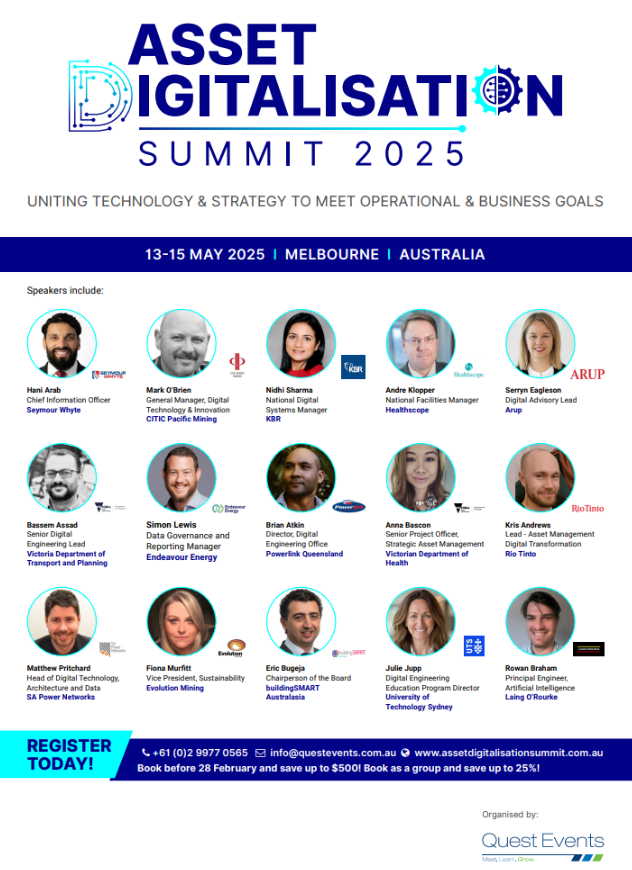Article: The risks of delaying asset digitalisation & how to find digitalisation success
Organisations across Australia must pursue digitalisation to avoid being left behind in an increasingly competitive commercial environment. As technology evolves at an accelerating pace, those that hesitate risk facing higher costs, inefficiencies, and a widening gap between themselves and digitally mature competitors.
Ahead of the Asset Digitalisation Summit 2025, we sat down with industry experts to discuss the risks of not digitalising and how advocates can overcome internal resistance to change, including:
- Ain Beruldsen, Group Manager, Data and Analytics, AusNet
- Mark O’Brien, General Manager, Digital Technology & Innovation, CITIC Pacific Mining
- Brian Atkin, Manager, Digital Engineering Office, Powerlink Queensland
- Andrew Mehr, Technical Director, Data and Analytics, Mott MacDonald
The consensus from these asset digitalisation leaders was clear: the costs of inaction outweigh any cost of change.
THE BIGGEST RISKS TO DELAYING ASSET DIGITALISATION
Ain Beruldsen of AusNet warned that the longer a company delays digitalisation, the harder it becomes to catch up. “The biggest business risk of delaying digitalisation is the continued increasing rate of change with which the digital environment evolves to solve increasingly complex problems. The step between where we are today and where we were two years ago may seem enormous, but the step between now and two years from now will be even larger.” Businesses that wait too long not only forgo a competitive edge but also leave substantial value on the table.
Similarly, Mark O’Brien from CITIC Pacific Mining highlighted the operational dangers of delaying digital transformation, particularly in asset heavy industries such as his native mining. “Waiting too long to go digital means higher costs, inefficiencies, and losing ground to more agile competitors. Mining companies that delay risk safety issues, unplanned downtime, and operational blind spots due to poor data visibility. Digital transformation isn’t just about staying ahead, it’s about not getting left behind.”
Beyond efficiency and cost savings, businesses also face talent-related risks. Brian Atkin at Powerlink Queensland emphasised that companies who failed to digitalise effectively would struggle to attract and retain top talent because younger generations expected modern, tech-driven workplaces. Additionally, organisations risked missing out on emerging AI-driven productivity and efficiency benefits, further widening the gap between digital leaders and slow-adopters.
Andrew Mehr from Mott MacDonald echoed these concerns, highlighting that construction had lagged behind industries like banking and travel in digital adoption. "We all expect seamless, digital-first experiences in our personal lives, whether it’s booking a flight or managing finances, yet construction and infrastructure still struggle with siloed data and fragmented workflows. The challenge isn’t just about adopting new tools; it’s about fundamentally rethinking how we work."
According to Mehr, companies that delay digitalisation risk inefficiencies, rising costs, and lost opportunities. "A McKinsey report found that large construction projects take 20% longer to complete and run up to 80% over budget due to outdated processes. That’s a massive gap that digital tools, like real-time data tracking and AI-driven forecasting, could help close. If businesses don’t move now, they risk being left behind by more agile competitors who are already optimising workflows and reducing waste."
GETTING BUY-IN & FINDING ASSET DIGITALISATION SUCCESS
Many engineers and asset managers already see the benefits of digitalisation, from removing ad hoc and menial tasks to streamlining data visibility, but how can they convince leadership? The key is demonstrating tangible business value.
O’Brien advises that securing board-level buy-in requires framing digitalisation around measurable outcomes and ROI. “Boards don’t invest in tech for tech’s sake; they care about business outcomes, so it’s crucial to frame digitalisation around cost savings, efficiency, and risk reduction.” He suggests starting with small pilot projects that deliver quick wins, building confidence and momentum for larger investments.
Mehr adds that ROI in construction isn’t always immediate, but the long-term gains are clear. "Deloitte reports that companies using AI and advanced analytics in construction increase productivity by up to 50% and reduce costs by 20%. Even in the short term, digital tools can improve efficiency, cut rework, and reduce material waste, delivering measurable value within 12-24 months."
Another crucial factor for overcoming resistance is cybersecurity. Atkin notes that as cyber threats grow, digitalisation becomes not just a competitive advantage but a necessity for business resilience. Companies that delayed asset digitalisation risked leaving critical infrastructure vulnerable, making them easy targets for cyberattacks.
UNLOCKING ROI & LONG-TERM SUCCESS THROUGH DIGITALISATION
The message from these experts is clear: delaying digitalisation comes with significant risks, from falling behind competitors to increased costs, inefficiencies, and cybersecurity vulnerabilities. As asset-intensive industries evolve, organisation that fail to embrace digitalisation will struggle to remain competitive, attract top talent, and safeguard operations. The key to overcoming resistance lies in demonstrating tangible business value, securing leadership buy-in through measurable ROI, and implementing strategic pilot projects.
Mehr sums it up best: "One of the biggest frustrations in our industry is that by the time a new technology is fully implemented, something even better is already on the market. That’s why businesses need to focus on adaptability. Instead of waiting for the 'perfect' tech solution, invest in scalable, evolving systems."
Digitalisation is no longer just an option; it is a necessity for ensuring long-term success and resilience in an increasingly digital world.
Hear from Ain, Mark, Brian, Andrew, and over 35 asset digitalisation leaders at the Asset Digitalisation Summit 2025 in Melbourne from 13-15 May 2025. Learn more.
To access the detailed conference program, download the brochure here.
Download the Brochure




